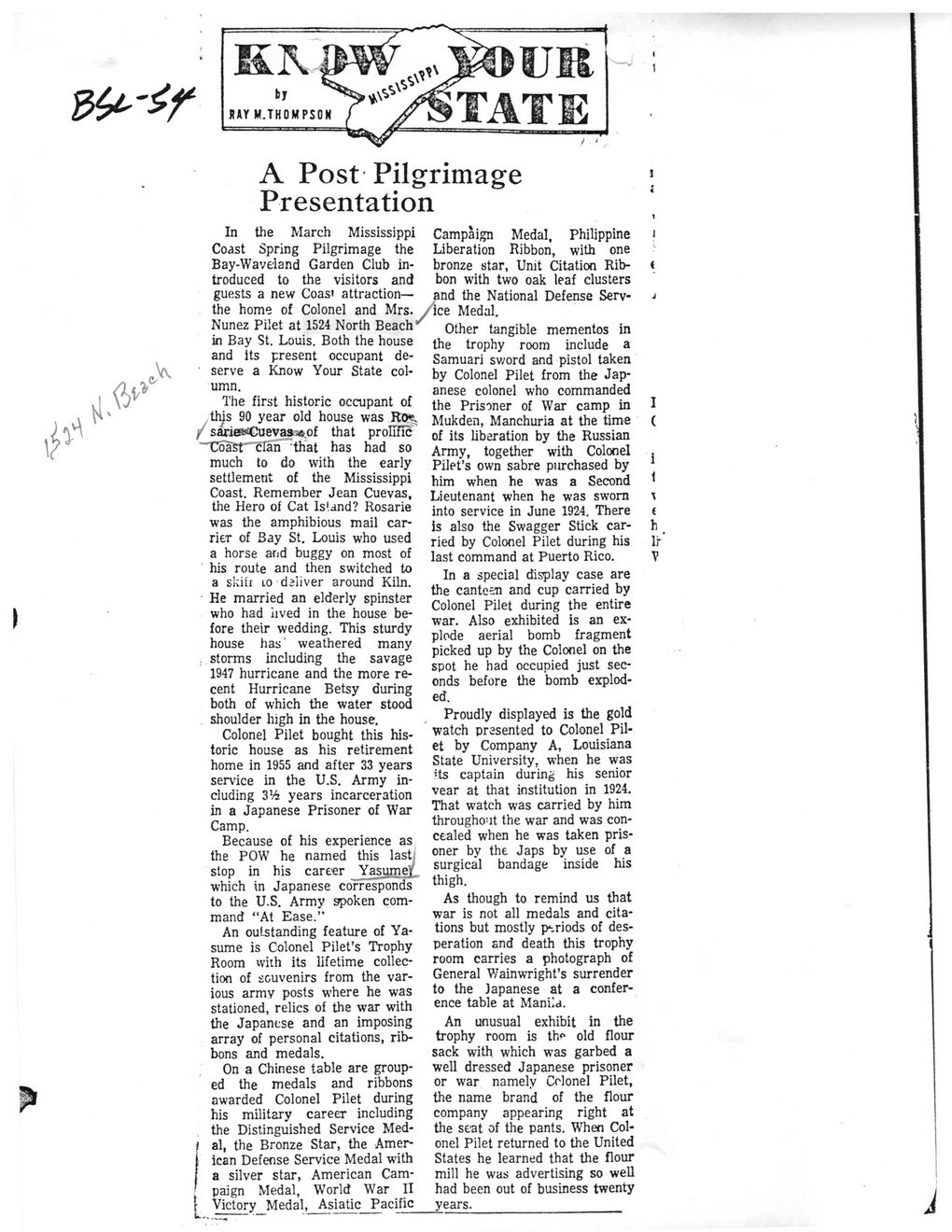This text was obtained via automated optical character recognition.
It has not been edited and may therefore contain several errors.
(I. A Post Pilgrimage Presentation In the March Mississippi Coast Spring Pilgrimage the Bay-Waveland Garden Club introduced to the visitors and guests a new Coast attraction— Campaign Medal, Philippine Liberation Ribbon, with one bronze star, Unit Citation Ribbon with two oak leaf clusters and the National Defense Serv- the home of Colonel and Mrs. /ice Medal. Nunez Pilet at 1524 North Beach Other tangible mementos in the trophy room include a Samuari sword and pistol taken by Colonel Pilet from the Japanese colonel who commanded the Prisoner of War camp in Mukden, Manchuria at the time in Bay St. Louis. Both the house and its present occupant deserve a Know Your State column. The first historic occupant of this 90 year old house was Ro*. / 7 . J— —-------------------------------------------------------------- iviuKueii, iviaricnuria ai uie nine f sanewCuevasa^of that prolific 0f jjs liberation by the Russian ~Coast-"cIah that has had so much to do with the early settlement of the Mississippi Coast. Remember Jean Cuevas, the Hero of Cat Island? Rosarie was the amphibious mail carrier of Bay St. Louis who used a horse and buggy on most of his route and then switched to a skiii io deliver around Kiln. He married an elderly spinster who had jived in the house before their wedding. This sturdy house has' weathered many . storms including the savage 1947 hurricane and the more recent Hurricane Betsy during both of which the water stood shoulder high in the house. Colonel Pilet bought this historic house as his retirement home in 1955 and after 33 years service in the U.S. Army including 3% years incarceration in a Japanese Prisoner of War Camp. Because of his experience as the POW he named this lasti stop in his career Yasumelr which in Japanese corresponds to the U.S. Army spoken command “At Ease.” An outstanding feature of Ya-sume is Colonel Pilet’s Trophy Room wiih its lifetime collection of souvenirs from the various army posts where he was stationed, relics of the war with the Japanese and an imposing array of personal citations, ribbons and medals. On a Chinese table are grouped the medals and ribbons awarded Colonel Pilet during his military career including the Distinguished Service Med-I al, the Bronze Star, the American Defense Service Medal with a silver star, American Campaign Medal, World War II I Victory Medal, Asiatic Pacific t— Army, together with Colonel Pilet’s own sabre purchased by him when he was a Second Lieutenant when he was sworn into service in June 1924. There is also the Swagger Stick carried by Colonel Pilet during his last command at Puerto Rico. In a special display case are the canteen and cup carried by Colonel Pilet during the entire war. Also exhibited is an explode aerial bomb fragment picked up by the Colonel on the spot he had occupied just seconds before the bomb exploded. Proudly displayed is the gold watch presented to Colonel Pilet by Company A, Louisiana State University, when he was its captain during his senior vear at that institution in 1924. That watch was carried by him throughout the war and was concealed when he was taken prisoner by the Japs by use of a surgical bandage inside his thigh. As though to remind us that war is not all medals and citations but mostly periods of desperation and death this trophy room carries a photograph of General Wainwright’s surrender to the Japanese at a conference table at Manila. An unusual exhibit in the trophy room is th*' old flour sack with which was garbed a well dressed Japanese prisoner or war namely Colonel Pilet, the name brand of the flour company appearing right at the scat of the pants. When Colonel Pilet returned to the United States he learned that the flour mill he was advertising so well had been out of business twenty years.___________________ ( h lr’ V

Bay Waveland Garden Club Bay Waveland Garden Club (151)